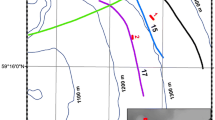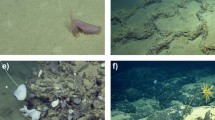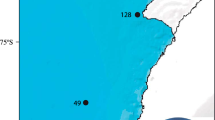Abstract
Nemertesia ramosa (Lamarck, 1816) is a large eurybathic hydrozoan species. Its habitat and spatial distribution in the Azores archipelago (central North Atlantic) are described based on 22 new records collected in situ by scuba diving and by observations using a drop-down camera and remote operated vehicles (ROVs) between 2004 and 2011. N. ramosa grows on hard substrates in mono and multi-specific assemblages. In the Azores it is well known in the sublittoral at 15–158 m depth in the central group of islands, but historical records exist from seamounts down to bathyal grounds of nearly 1000 m. Scuba diving surveys generally reveal N. ramosa as an occasionally occurring and rare species in the infralittoral (1–9 colonies 10−3 m−2), although it may also be common and even abundant at some sites. A circalittoral aggregation was assessed in detail exhibiting densities of up to 2.82 colonies m−2 on rocky substrate and one order of magnitude lower on mixed bottom (0.25–0.55 colonies m−2). An aggregated spatial distribution is described, with aggregations being considered hydroid gardens (>1–9 10−1 m−2). Colonies measured on ROV imagery averaged 23.5 cm in height (STD = 4.1). Taller colonies (max = 36.7 cm) were registered on rocky outcrops protruding more than 15 cm. N. ramosa co-occurred mainly with brown and red algae, bryozoans, polychaetes, and other hydroids. A diverse ichthyofauna was associated to these habitats. Circalittoral communities of N. ramosa included hydrozoans, sponges, and fish.





Similar content being viewed by others
References
Andrews AH, Cordes EE, Mahoney MM, Munk K, Coale KH, Cailliet GM, Heifetz J (2002) Age, growth and radiometric age validation of a deep-sea, habitat-forming gorgonian (Primnoa resedaeformis) from the Gulf of Alaska. Hydrobiologia 471:101–110
Bliss C (1958) The analysis of insect counts as negative binomial distributions. Proc 10th Int Congr Entomol, pp 1015–1032
Broch H (1918) Hydroida. (Part II) Danish Ingolf-expedition, vol 5. Zoological Museum of the University, Copenhagen
Bullimore RD, Foster NL, Howell KL (2013) Coral-characterized benthic assemblages of the deep Northeast Atlantic: defining “Coral Gardens” to support future habitat mapping efforts. ICES J Mar Sci 70:511–523
Calder DR, Vervoort W (1998) Some hydroids (Cnidaria: Hydrozoa) from the Mid-Atlantic Ridge, in the North Atlantic Ocean. Zool Verh Leiden 319:1–65
Carré C (2010) COVER - Customizable Observation Video Image Record. User manual v0.8.4, Ifremer
Connor DW, Allen JH, Golding N, Lieberknecht LM, Northen KO, Reker JB (2003) The national marine habitat classification for Britain and Ireland. Joint Nature Conservation Committee, Peterborough
Cornelius PF (1992) The Azores hydroid fauna and its origin, with discussion of rafting and medusa suppression. Arquipel Life Mar Sci 10:75–99
Davies CE, Moss D, Hill MO (2004) EUNIS habitat classification. Revision 2004. European Environment Agency. European Topic Centre on Nature Protection and Biodiversity, Copenhagen
Frechette M, Butman CA, Geyer WR (1989) The importance of boundary-layer flow in supplying phytoplankton to the benthic suspension feeder, Mytilus edulis L. Limnol Oceanogr 34:19–36
Gomes-Pereira JN, Tempera F, Ribeiro P, Porteiro FM (2012) Notes on fauna associated with an opportunistic artificial reef near cold-water corals. Arquipel Life Mar Sci 29:69–75
Greene HG, Yoklavich MM, Starr RM, O’Connell VM, Wakefield WW, Sullivan DE, McRea JE Jr, Cailliet GM (1999) A classification scheme for deep seafloor habitats. Oceanol Acta 22:663–678
Harms J (1990) Marine plastic litter as an artificial hard bottom fouling ground. Helgolander Meeresun 44:503–506
Heip C (1975) On the significance of aggregation in some benthic marine invertebrates. In: Barnes H (ed) Proc. 9th Europ Mar Biol Symp. Aberdeen University Press, Aberdeen, pp 527–538
Heip C (1976) The spatial pattern of Cyprideis torosa (Jones, 1850) (Crustacea: Ostracoda). J Mar Biol Assoc UK 56:179–189
Henry L-A, Nizinski MS, Ross SW (2008) Occurrence and biogeography of hydroids (Cnidaria: Hydrozoa) from deep-water coral habitats off the southeastern United States. Deep-Sea Res I Oceanogr Res Pap 55:788–800
Henry L-A, Moreno Navas J, Roberts J (2013) Multi-scale interactions between local hydrography, seabed topography, and community assembly on cold-water coral reefs. Biogeosciences 10:17885–17912
Hiscock K (1996) Marine Nature Conservation Review: rationale and methods. Joint Nature Conservation Committee, Peterborough
Holt R, Sanderson W (2001) Procedural guideline 3-5: identifying biotopes using video recordings. In: Davies J et al (eds) Natura 2000 marine monitoring handbook, UK Marine SACs Project. Joint Nature Conservation Committee, Peterborough
Hughes R (1977) Aspects of the biology and life-history of Nemertesia antennina (L.) (Hydrozoa: Plumulariidae). J Mar Biol Assoc UK 57:641–657
Hughes R (1986) Differences in the growth, form and life history of Plumularia setacea (Ellis and Solander)(Hydrozoa: Plumulariidae) in two contrasting habitats. Proc R Soc Lond B Biol Sci 228:113–125
Madden C, Goodin K, Allee R, Cicchetti G, Moses C, Finkbeiner M, Bamford D (2009) Coastal and marine ecological classification standard. NOAA and Nature Serv. Available online: http://www.csc.noaa.gov/benthic/cmecs/, 107 pp
Millard NAH (1975) Monograph on the Hydroida of southern Africa. Ann S Afr Mus 68:1–513
Morato T, Machete M, Kitchingman A, Tempera F, Lai S, Menezes G, Pitcher TJ, Santos RS (2008) Abundance and distribution of seamounts in the Azores. Mar Ecol Prog Ser 357:17–21
Moura CJ, Cunha MR, Porteiro FM, Yesson C, Rogers AD (2011) Evolution of Nemertesia hydroids (Cnidaria: Hydrozoa, Plumulariidae) from the shallow and deep waters of the NE Atlantic and western Mediterranean. Zool Scr 41:79–96
Moura CJ, Cunha MR, Porteiro FM, Yesson C, Rogers AD (2012) Evolution of Nemertesia hydroids (Cnidaria: Hydrozoa, Plumulariidae) from the shallow and deep waters of the NE Atlantic and Western Mediterranean. Zoologica Scripta 41(1):79–96. doi:10.1111/j.1463-6409.2011.00503.x
OSPAR (2008) OSPAR list of threatened and/or declining species and habitats. OSPAR Agreement. 2008-06
Pictet C, Bedot M (1900) Hydraires provenant des campagnes de l’Hirondelle, 1886–1888. Résult Camp Scient Prince de Monaco 18:1–59
Picton BE, Morrow CC (2010) Encyclopedia of marine life of Britain and Ireland. http://www.habitas.org.uk/marinelife/species.asp?item=D599. Accessed 23 Oct 2013
Porteiro FM, Gomes-Pereira J, Pham CK, Tempera F, Santos RS (2013) Distribution and habitat association of benthic fish on the Condor seamount (NE Atlantic, Azores) from in situ observations. Deep-Sea Res II Top Stud Oceanogr 98:114–128
Porter J (2012) Seasearch guide to bryozoans and hydrozoans of Britain and Ireland. Marine Conservation Society, UK
Ramil F, Vervoort W (1992) Report on the Hydroida collected by the “ BALGIM ” expedition in and around the Strait of Gibraltar. Zool Verh Leiden 277:3–262
Rees W, White E (1966) New records and fauna list of hydroids from the Azores. Ann Mag Nat Hist 9:271–284
Santos RS, Hawkins S, Monteiro LR, Alves M, Isidro EJ (1995) Marine research, resources and conservation in the Azores. Aquat Conserv 5:311–354
Sommer C (1992) Larval biology and dispersal of Eudendrium racemosum (Hydrozoa, Eudendriidae). Sci Mar 56:205–211
Strong JA, Service M, Plets R, Clements A, Quinn R, Breen J, Edwards H (2012) Marine substratum and biotope maps of the Maidens/Klondyke bedrock outcrops, Northern Ireland. J Maps 8:129–135
Tempera F, Pereira JN, Henriques AB, Porteiro F, Morato T, Matos V, Souto M, Guillaumont B, Santos RS (2012) Cataloguing deep-sea biological facies of the Azores. Rev Investig Mar 19:36–38
Tempera F, Atchoi E, Amorim P, Gomes-Pereira J, Gonçalves J (2013) Atlantic area marine habitats. Adding new Macaronesian habitat types from the Azores to the EUNIS Habitat Classification. Tech Rep No. 4/2013 - MeshAtlantic, IMAR/DOP-UAç, Horta
Thrush S, Hewitt JE, Cummings VJ, Dayton PK, Cryer M, Turner SJ, Funnell GA, Budd RG, Milburn CJ, Wilkinson MR (1998) Disturbance of the marine benthic habitat by commercial fishing: impacts at the scale of the fishery. Ecol Appl 8:866–879
Underwood A, Chapman M (1996) Scales of spatial patterns of distribution of intertidal invertebrates. Oecologia 107:212–224
Wentworth CK (1922) A scale of grade and class terms for clastic sediments. J Geol 30:377–392
Williams G (1976) Aggregation during settlement as a factor in the establishment of coelenterate colonies. Ophelia 15:57–64
Acknowledgments
We acknowledge: Ricardo Serrão Santos, Filipe Porteiro, and Telmo Morato (IMAR-DOP/UAz) for their coordination and support throughout the projects mentioned below; Jorge Fontes, Frederico Cardigos, Vanessa Santos, Jaen Nieto Amat, Ricardo Delgado, and Pedro Frade for their collaboration in the scuba-diving surveys; David Abecasis and Manuela Ramos for their help in the ROV and drop-down camera surveys; Renato Bettencourt for his proficiency in piloting ROV SP; the crews of RV Arquipélago and RL Águas Vivas for their competence during the surveys; the dedicated editorial work by B. W. Hoeksema and detailed revisions from Lea-Anne Henry and one anonymous referee that contributed to improve this manuscript. Data collection and analysis was supported by projects MARÉ (Life-Nature B4-3200/98/509), MAROV (PDCTM/P/MAR/15249/1999), MAYA (AdI/POSI/2003), OGAMP (INTERREG IIIb - MAC/4.2/A2 2001), MARMAC (INTERREG IIIb - 03/MAC/4.2/A2 2004), CORALFISH (FP7 ENV/2007/1/21314 4), CORAZON (FCT/PTDC/MAR/72169/2006) and MeshAtlantic (AA-10/1218525/BF). Frederico Dias as coordinator of Project M@rbis (EMEPC). IMAR-DOP/UAz is Research and Development Unit no. 531 funded by the Portuguese Foundation for Science and Technology (FCT) through pluriannual and programmatic funding schemes (OE, FEDER, POCI2001, FSE) and by the Azores Directorate for Science and Technology (DRCT). JNGP was supported by the doctoral grant from the Regional Directorate for Science, Technology and Communications (DRCTC) of the Regional Government of the Azores (M3.1.2/F/062/2011). Fernando Tempera was supported by a post-doc grant from the Portuguese Foundation for Science and Technology (ref. SFRH/BPD/79801/2011).
Author information
Authors and Affiliations
Corresponding author
Additional information
Communicated by B. W. Hoeksema
Electronic supplementary material
Below is the link to the electronic supplementary material.
ESM Table 1
(DOCX 35 kb)
ESM Table 2
(DOCX 23.1 kb)
ESM Table 3
(DOCX 24.5 kb)
Rights and permissions
About this article
Cite this article
Gomes-Pereira, J.N., Tempera, F. Hydroid gardens of Nemertesia ramosa (Lamarck, 1816) in the central North Atlantic. Mar Biodiv 46, 85–94 (2016). https://doi.org/10.1007/s12526-015-0325-9
Received:
Revised:
Accepted:
Published:
Issue Date:
DOI: https://doi.org/10.1007/s12526-015-0325-9




